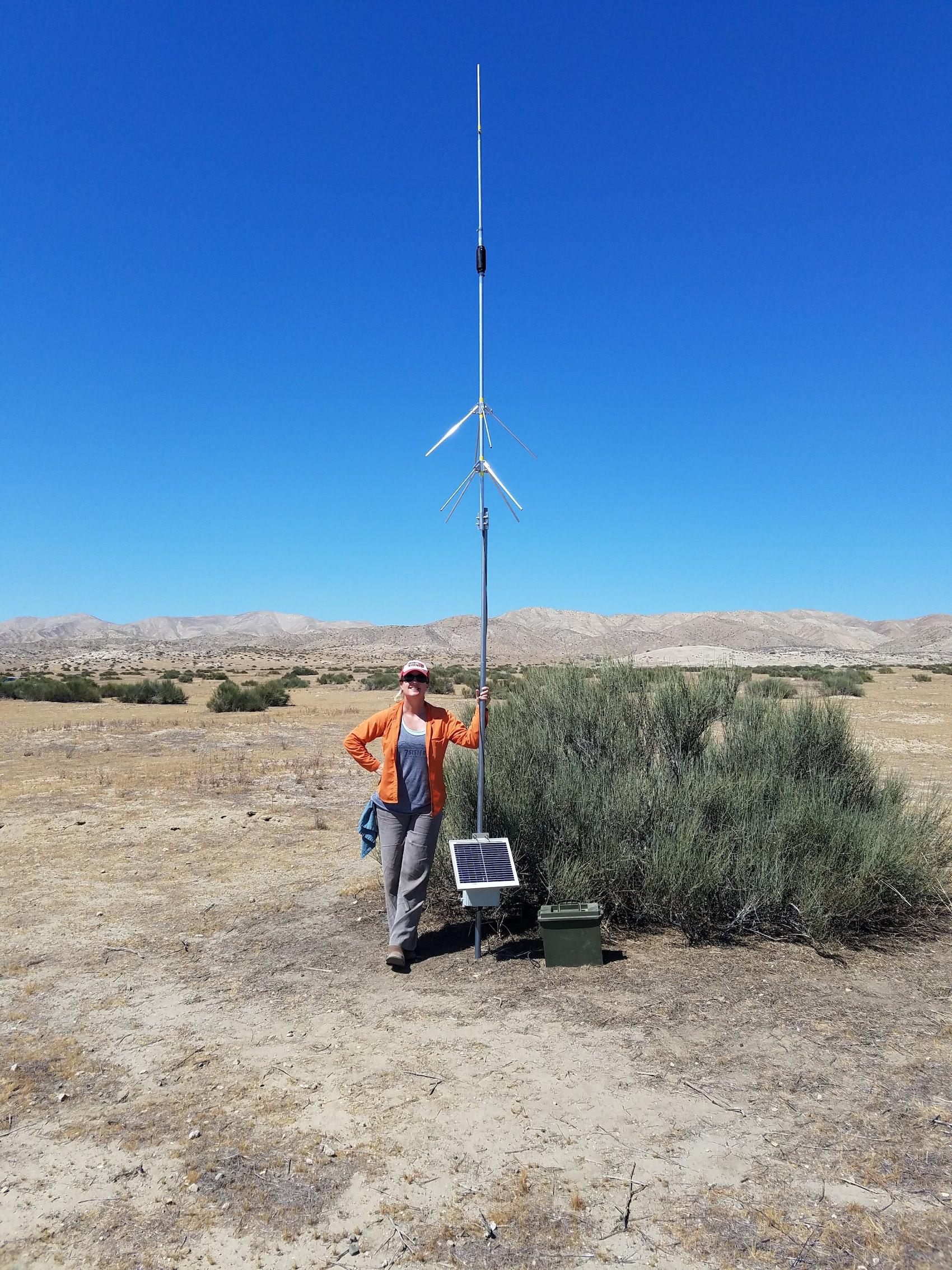To Track a Snake
If I ask you to close your eyes and conjure an image associated with "wildlife radio-telemetry," I'll bet you picture something along the lines of a flannel-clad scientist standing on a bluff, pointing his antenna toward a distant herd of elk sporting thick collars bearing large VHF radio-transmitters that permit him to follow their movements across the Yellowstone landscape. Indeed, the development of these transmitters beginning in the 1950's paved the way for scientists to easily follow individual animals, revolutionizing ecology.
So, when I tell people that I use radio-telemetry to study rattlesnakes, they invariably ask "How can you put a radio-collar on a snake... they don't have necks!" Whether snakes are neckless or are basically just one long neck is debatable, but the point is that they cannot be studied with radio-collars. Plus, snakes and the rest of their reptile and amphibian brethren (called "herps" from the word herpetology, which is the study of these creatures) tend to be much smaller than elk, so even attaching the transmitters to the animal in some other way can be challenging.
"Snakes and other herps were largely left out of the first 20 years of the telemetry revolution."
Because of these constraints, snakes and other herps were largely left out of the first 20 years of the telemetry revolution, where rapidly evolving technology allowed scientists to peer into the secret lives of wildlife. Given how secretive snakes are, this meant that research examining habits of individual snakes over time was scarce, and their biology was only recorded as snapshots in time.
This all changed in the late 1960's, when scientists force-fed radio-transmitters into several species of snakes (1) and tracked them for about one month (the maximum battery life of the transmitters). The transmitters were also rather heavy, comprising as much as 27% of the snake's mass. Imagine if you were abducted by aliens and force-fed a Costco-sized bag of dog kibble before being released... would you move around normally? Probably not.
Manufacturers worked on improving transmitter battery life and size, paving the way for the next breakthrough when scientists developed a method to successfully surgically implant radio-transmitters in snakes (2) in the early 1980's. While surgery is a highly invasive procedure, snakes tend to recover well and resume normal behaviors rapidly. Thousands of studies have used this method in the 40 years since it was developed, allowing discoveries ranging from snake habitat preferences to hunting strategies to social behavior.
Nowadays, there is a radio-transmitter available for most any type of snake, ranging from 0.3 grams with a battery life of about 3 weeks, to about 30 grams with batteries lasting up to 4 years. Researchers try to keep transmitters under 5% of the animal's body weight. Surgical implantation is still the most common method for snakes, but transmitters can be deployed externally on other kinds of herps. For example, transmitters are regularly epoxied to turtle shells and alligator skin, inserted into "backpacks" or glued to bead chains to make radio-collars for lizards, and attached to frogs using waist bands (Figure 1). For exceptionally large reptiles that migrate long distances, like sea turtles, GPS collars transmit the turtle's location to satellites whenever they surface to breathe, allowing scientists to follow the turtles' movements from their office computers.
Figure 1: Some examples of radio-transmitter attachment styles commonly used to study reptiles and amphibians.

(a) Surgically implanted Holohil VHF radio- transmitter in a rattlesnake

(b) Vemco acoustic transmitter on a turtle (photo courtesy James Van Dyke)

(c) Holohil VHF radio-collar on a lizard (photo courtesy Spencer Riffle, USFWS permit TE-166383-5)

(d) Waist band Holohil VHF radio-transmitter on a frog (photo courtesy Joseph Altobelli)

(e) Wildlife Computers, Inc. GPS satellite tag attached to a sea turtle's carapace (photo courtesy Jim Stevenson, Florida permit MTP-051 to Dean Bagley)

(f) Lotek GPS- archiving tag attached to a rattlesnake's rattle (photo courtesy Scott Boback)
"Herp researchers like me have a mile-long tech wish list when it comes to transmitters."
Herp researchers like me have a mile-long tech wish list when it comes to transmitters, some of which are currently being granted by manufacturers. As a physiologist, I dream of surgically implanting a transmitter into a rattlesnake that can archive heart rate, blood oxygen levels, movement speed, and body temperature. While most of these can easily be measured and archived in large enough animals, miniaturization with sufficient memory and battery life remains a challenge for scientists studying reptiles smaller than sea turtles and alligators.
Temperature, in particular, is a key variable for reptiles and amphibians. While transmitters themselves do not typically log temperature, scientists certainly have figured out how to use telemetry to help log data on this important variable.
Turn Up the Heat
As the only terrestrial vertebrate ectotherms, reptiles and amphibians regulate their body temperatures primarily by careful selection of their microhabitat. The term "cold- blooded" is a fairly poor choice to describe them, as their temperatures can regularly exceed those of "warm-blooded" mammals or birds when they bask in the sun. Herps' dependence on the environment for heat has placed them squarely as focal species for studying how climate change will impact biodiversity (3). As such, appropriate technology for measuring body temperature is key.
Researchers can head into the field to capture a snake and measure its body temperature, but that can stress the snake and only gives a single snapshot datum, which does not represent temperature over an entire day (4). So, researchers have developed two main ways to continuously log temperature in herps. Both involve telemetry.
Many transmitter manufacturers can add temperature-sensitivity to transmitters upon request. Transmitters are manufacturer-calibrated such that the interval between pulses is temperature-dependent, and researchers can log these interpulse intervals and later convert them to temperature (deep body temperature for implanted transmitters, surface temperature for collars or other external transmitters).
Logging the interpulse interval with a stopwatch while tracking snakes is impractical for the same reason as jabbing it with a thermometer: it only yields a point sample. In the 1990's, researchers engineered their own data-logging systems by deploying arrays consisting of a battery-powered receiver and antenna with laptop that toggled among snake frequencies and stored their interpulse intervals (5). Several manufacturers have created dedicated data acquisition systems for continuous scanning and logging of temperatures in the field (Figure 2).
Figure 2: This solar-powered Telonics data acquisition system array scans individual radio-transmitter frequencies and records interpulse intervals, which the researcher later converts to animal body or surface temperatures using manufacturer-provided calibration curves.
One major problem with stationary temperature data acquisition systems is that the animals must remain within range of the receiver array for data to be collected. For highly labile animals that regularly move outside of range, the method does not work. This problem was solved around the year 2000 with the advent of miniature temperature data loggers, originally designed to log temperatures of pharmaceuticals and perishable food shipments but quickly adapted by scientists for use in logging body temperatures of reptiles and amphibians (Figure 3). Researchers have developed several ways to further miniaturize these data loggers to reduce the burden on very small animals (6, 7, 8).

Figure 3: Temperature data loggers such as Thermochron iButtons can be programmed to log temperature at desired intervals, covered in waterproof coating, and surgically implanted inside animals (note suture in (a) to anchor logger to ribs) or

(b) attached to their body surface with an adhesive, like this iButton modified for reduced mass per (8) on a skink (photo courtesy Jo Virens)
"We have an obligation to harness the full extent of the technology available to us to better predict how climate change will impact animals so that mitigation measures can be taken."
Data loggers have their own downside in field settings, including the fact that animals must be tracked consistently so we know where they are to facilitate retriveal of data loggers at the end of the study. Early failure of the radio-transmitter battery or data logger hardware, or predation or disappearance of the animal for another reason, mean that the data are gone.
For most of my career over the past 20 years, radio-telemetry technology for reptiles and amphibians has remained relatively static. Yet in the past several years I've been tantalized by rumors of new prototypes emerging from various manufacturers, including extreme miniaturization, archiving of physiological parameters, RFID applications for animal movement, solar charging to extend battery life, Bluetooth data transfer from surgically implanted data loggers, and much more. It is an exciting time to be a field biologist. We have an obligation to harness the full extent of the technology available to us to better predict how climate change will impact animals so that mitigation measures can be taken. Our ability to do this type of science relies on creative and responsive tech development by manufacturers.
Sources:
1: https://www.jstor.org/stable/pdf/1441605.pdf
2: https://www.jstor.org/stable/1444674
3: https://doi.org/10.1002/jez.2396
4: https://www.sciencedirect.com/science/article/abs/pii/S0306456503000974
5: https://www.jstor.org/stable/3892726
6: https://link.springer.com/article/10.1007%2Fs00360-008-0329-x
7: http://www.elin.ru/files/pdf/Application/118RobertThompson2003.pdf
8: https://jeb.biologists.org/content/221/11/jeb176354
About the Author

Emily Taylor is a Professor of Biological Sciences at the California Polytechnic State University in San Luis Obispo, California, where she is the supervisor of the Physiological Ecology of Reptiles Laboratory. She also runs a rattlesnake rescue and consulting company, Central Coast Snake Services. Find her on Twitter at @snakeymama and @coastsnake.
15 September 2023 11:02pm
Hi, have we had any break throughs in radio transmitters for snakes, surgery is way too invasive in my opinion. It works but we need to look at different technologies.
16 October 2023 4:07pm
Hi, I would also be interested if any new technologies recently turned up and if you may have a list of producers?




Edgar M. fortune